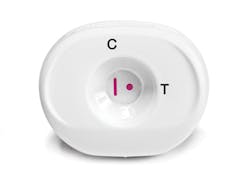Rapid testing for HIV: the state of the art, and a look ahead
Knowledge is power when it comes to controlling the spread of human immunodeficiency virus (HIV). Patients must be aware of their positive status before they can be connected with appropriate treatments and counseling. The Centers for Disease Control and Prevention (CDC) estimates that in the United States alone, 180,900 individuals over the age of 13 are unaware that they are infected with HIV.1
Health organizations use rapid HIV testing in both clinical and nonclinical settings to combat infection rates. Rapid HIV testing has been particularly effective in point-of-care testing (POCT), where speedier results have helped decrease failure-to-return (FTR) rates. At CDC screening events that included rapid testing, 98% of tested individuals returned for their results. The return rate was only 47% for screening events that did not include rapid tests.2
Lateral flow tests
When they were introduced in the early 1990s, lateral flow tests dramatically transformed the diagnostics world. They gave medical professionals the power to generate a qualitative result right at the point of care, eliminating the need to transport samples or wait for laboratory results. Also, the process was simple and required little training; one could apply a blood sample to the device, and after a relatively short period of time, view a positive or negative result in a simple results window.
- Rapid tests detect HIV infection with very good correlation with tests approved for use on auto-analyzers. Many of these assays show sensitivity and specificity exceeding 99.7%, which is comparable to third-generation tests on analyzers.3
- However, a case can be made that rapid assays have not significantly improved since they were introduced. The lack of improvement in three areas in particular has made it difficult for rapid (lateral flow) tests to gain a foothold in the clinical laboratory market.
- These tests are not really that rapid when compared to other lab-based diagnostics such as blood glucose tests. The time to result after sample preparation is often 20 to 30 minutes. That does not offer a significant advantage over the current tests that can be performed using analyzers, which take approximately 30 minutes.
- The tests give only a qualitative answer. While positive or negative result is sufficient for a simple screening test, more complex lab-based systems provide quantitative results to monitor infection progression and guide treatment.The tests are read manually and therefore do not feed into the Laboratory Information Management System (LIMS)—an integral part of the modern clinical lab. This necessitates a manual data entry step, which adds more time to the process.
- A new generation of rapid tests uses a different kind of technology—vertical flow—that overcomes many of the limitations of lateral flow-based technology.
Vertical flow tests
Rapid vertical flow HIV tests can provide clinical professionals with more information. They reduce test time. While the test time in lateral flow assays is limited due to the nature of the materials and the test format, vertical flow technology uses gravity to rapidly draw the sample and reagents down through membrane and produce almost instant results. The test takes two minutes.
The ability to give instant results can have a significant impact upon the way in which the tests are used:
- Besides significantly reducing the FTR rate, it has an impact in time-critical applications (e.g., emergency or disaster response situations) or situations where the patient is present and counseling may be required (e.g., occupational exposure and screening programs). In such circumstances, the results are available while the patient is still present.
- No timer is needed to conduct the test. Once the sample is applied, the result is immediately delivered.
- Among other benefits associated with the rapid vertical flow technique are the separation of sample and conjugate, which is conducive to better performance, and the “hook effect”: in lateral flow, undiluted specimen will overwhelm the internal color conjugate upon reaction, prior to moving toward the reaction zone.
Enabling greater clinical adoption
Due to shrinking budgets and reduced human resources, healthcare providers are increasingly focused on the business case for rapid testing. It has never been more critical for the diagnostic industry to provide more value for investment. Multiplexing is the first step in this direction, giving healthcare providers the ability to obtain multiple results from a single test cartridge with a single drop of sample.
Multiplexing is a challenge in traditional rapid assays formats, as each additional result directly increases the time taken for the test to be completed. In contrast, vertical flow technology's orientation enables independent testing zones on the same membrane to eliminate cross-reactivity and enable multiplexing. The same resources, human and material, are expended in performing a multiplex test as would be in performing a single test.
Automation is the next step toward a rapid HIV test that provides more value for the investment. The modern hospital is highly automated; the handling and flow of samples from initial receipt to storage of the result is normally performed with little or no human intervention. Conversely, traditional rapid HIV assays are read by eye and results are entered manually into the LIMS. The result is an increasing desire among healthcare providers to interpret and record results automatically.
Instrument-based interpretation of assay results will eliminate the need for human input by directly uploading the assay results into the patient record. An instrument reading the results will remove user variation, as human visual interpretation of results can give different results for the same intensity of the capture line. Using an instrument that will quantify the intensity of the reading can remove the potential human variation.
References
- Centers for Disease Control and Prevention. Monitoring selected national HIV prevention and care objectives by using HIV surveillance data—United States and 6 U.S. dependent areas—2011. HIV Surveillance Supplemental Report. 2013;18(5). Published October 2013.
- Centers for Disease Control and Prevention. HIV Testing at CDC-Funded Sites, United States, Puerto Rico, and the U.S. Virgin Islands, 2010. Atlanta, GA: U.S. Department of Health and Human Services, September 2012.
- Owen SM, Yang C, Spira T. Alternative algorithms for human immunodeficiency virus infection diagnosis using tests that are licensed in the United States. J Clin Microbiol.2008;46(5):1588-1595.


